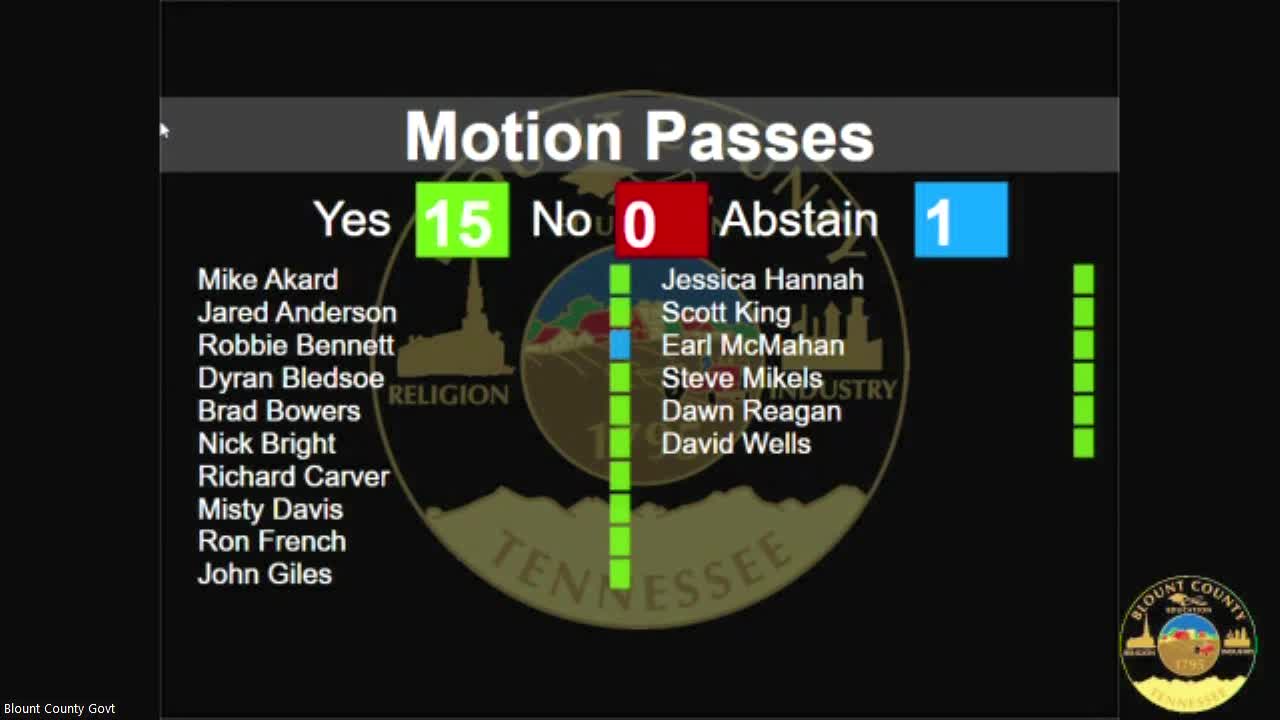Blount County debates controversial stormwater regulations
August 15, 2024 | Blount County, Tennessee
This article was created by AI summarizing key points discussed. AI makes mistakes, so for full details and context, please refer to the video of the full meeting. Please report any errors so we can fix them. Report an error »

In a recent meeting of the Blount County Commission, several resolutions concerning employee benefits and environmental regulations were adopted, despite significant debate and concerns raised by some commissioners.
The commission unanimously approved Resolution 24 8013, establishing the medical premium rate structure for county employees, effective January 1, 2025. The vote was 15 in favor with one abstention. Following this, Resolution 24 8014, which sets the dental premium rate structure, also passed with 14 votes in favor and two abstentions, including one from Commissioner Reagan due to a conflict of interest.
Resolution 24 8015, amending the employee handbook, and Resolution 24 8016, modifying the classification and compensation policy, were both adopted with similar support, each receiving 15 votes in favor and one abstention.
However, the most contentious discussion arose around Resolution 24 8017, which aims to adopt regulations to prevent water contamination from illicit discharges in unincorporated areas of Blount County. This resolution is part of compliance with the Clean Water Act and requires local governments to implement specific regulations to avoid potential fines from state and federal agencies.
Commissioners expressed strong concerns about the necessity and implications of the resolution. Commissioner Akers questioned the need for local regulations when federal laws already exist, arguing that the county should not assume additional responsibilities that could lead to increased costs and liabilities. Other commissioners echoed similar sentiments, suggesting that the regulations could impose undue restrictions on local businesses and residents, such as prohibiting certain types of water discharges that could affect everyday activities.
Despite the pushback, the resolution was ultimately adopted, with the commission voting 12 in favor and 4 against. The discussions highlighted a growing tension between local governance and federal mandates, with several commissioners advocating for a more cautious approach to compliance with state and federal regulations.
The meeting underscored the complexities of local governance in the face of federal environmental regulations and the ongoing debate about the balance between compliance and local autonomy.
The commission unanimously approved Resolution 24 8013, establishing the medical premium rate structure for county employees, effective January 1, 2025. The vote was 15 in favor with one abstention. Following this, Resolution 24 8014, which sets the dental premium rate structure, also passed with 14 votes in favor and two abstentions, including one from Commissioner Reagan due to a conflict of interest.
Resolution 24 8015, amending the employee handbook, and Resolution 24 8016, modifying the classification and compensation policy, were both adopted with similar support, each receiving 15 votes in favor and one abstention.
However, the most contentious discussion arose around Resolution 24 8017, which aims to adopt regulations to prevent water contamination from illicit discharges in unincorporated areas of Blount County. This resolution is part of compliance with the Clean Water Act and requires local governments to implement specific regulations to avoid potential fines from state and federal agencies.
Commissioners expressed strong concerns about the necessity and implications of the resolution. Commissioner Akers questioned the need for local regulations when federal laws already exist, arguing that the county should not assume additional responsibilities that could lead to increased costs and liabilities. Other commissioners echoed similar sentiments, suggesting that the regulations could impose undue restrictions on local businesses and residents, such as prohibiting certain types of water discharges that could affect everyday activities.
Despite the pushback, the resolution was ultimately adopted, with the commission voting 12 in favor and 4 against. The discussions highlighted a growing tension between local governance and federal mandates, with several commissioners advocating for a more cautious approach to compliance with state and federal regulations.
The meeting underscored the complexities of local governance in the face of federal environmental regulations and the ongoing debate about the balance between compliance and local autonomy.
View full meeting
This article is based on a recent meeting—watch the full video and explore the complete transcript for deeper insights into the discussion.
View full meeting
